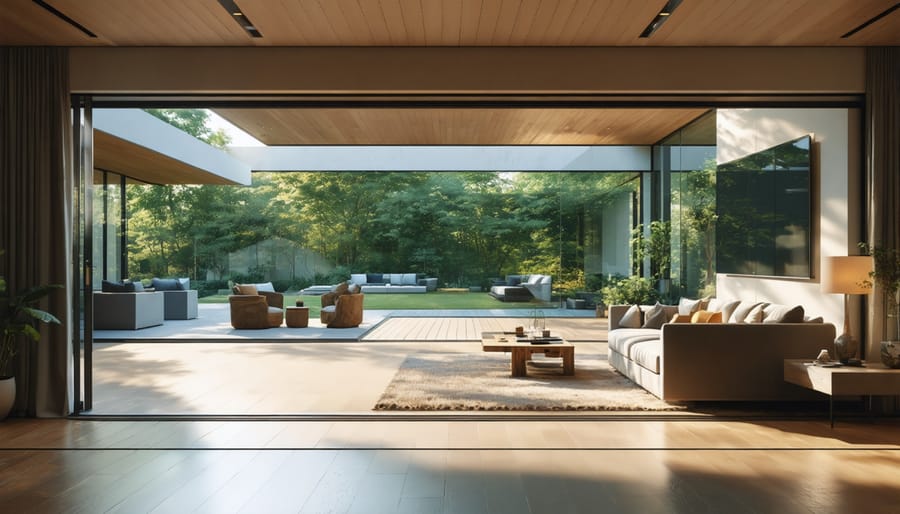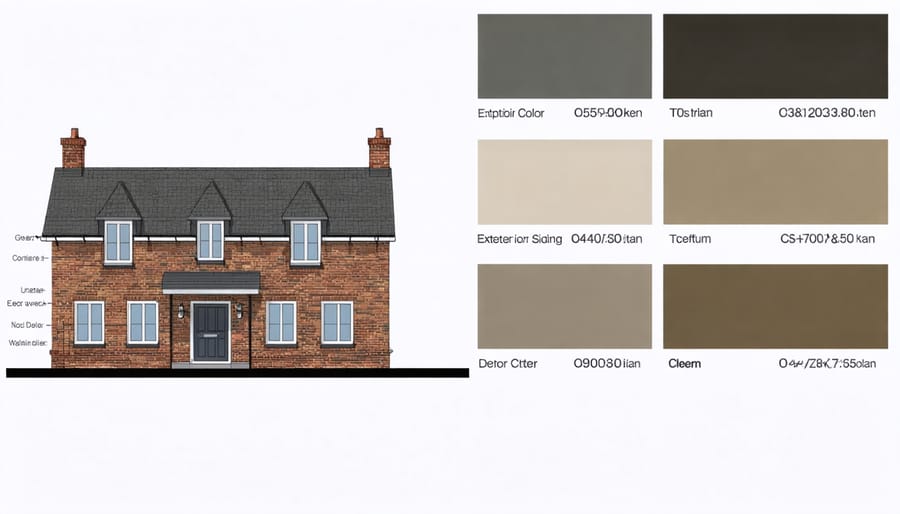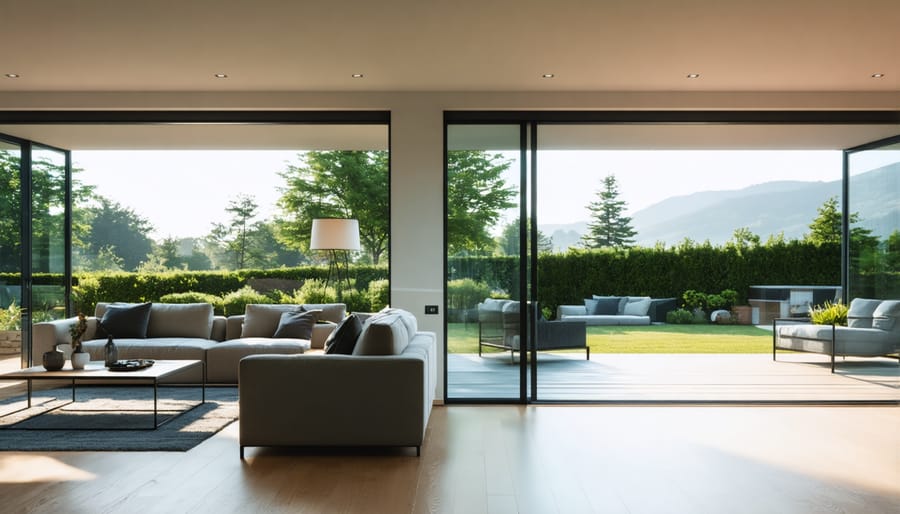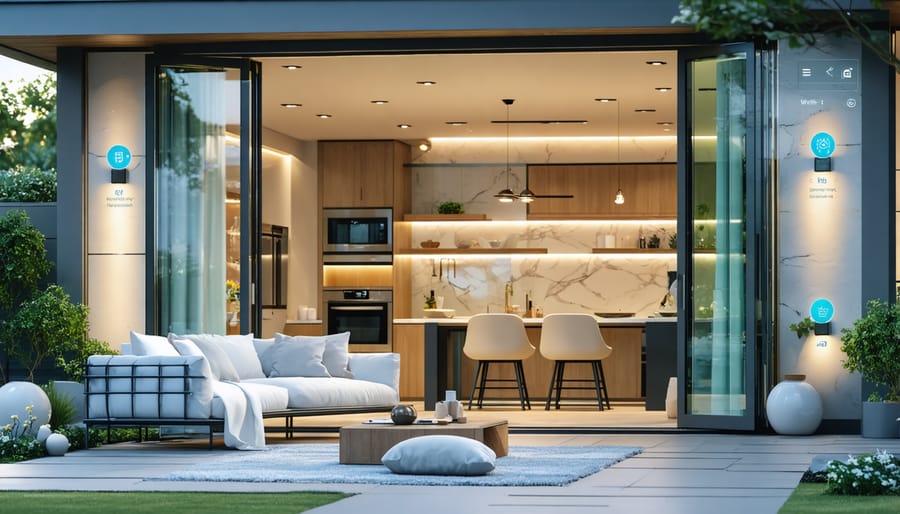
Beautiful Inside and Out: Simple Steps to Blend Your Home’s Style
Create flow between rooms by selecting consistent flooring materials, repeating key colors, and maintaining similar design elements throughout your living spaces. Harmonizing your home’s design requires thoughtful transitions that guide the eye naturally from one area to the next. Connect indoor and outdoor spaces through large windows, sliding glass doors, and coordinated color palettes that reflect nature’s elements. Install smart lighting systems that adjust throughout the day, maintaining visual consistency while enhancing each room’s unique purpose. Choose furniture pieces that complement rather than match exactly, creating subtle variations within your chosen style theme. This deliberate approach to spatial planning transforms disconnected rooms into a cohesive living environment where every element serves both function and flow.
Creating Your Home’s Design Story
Finding Your Architectural Style
Every home tells a story through its architectural features, and understanding these elements is key to creating a harmonious design. Start by identifying your home’s basic architectural style – whether it’s a Colonial, Victorian, Modern, or Ranch-style home. Look for defining characteristics like roof lines, window shapes, and exterior materials that make your home unique.
Pay attention to the proportion and scale of your home’s features. Are there prominent columns, arched doorways, or specific window patterns? These elements should guide your design choices, from furniture selection to decorative accents. For example, a Mid-century Modern home with clean lines and large windows calls for different design approaches than a Traditional home with ornate moldings.
Consider how your home’s architectural period influences its design language. Modern homes often embrace minimalism and open spaces, while Craftsman-style homes celebrate natural materials and handcrafted details. By aligning your design choices with your home’s architectural DNA, you create a more cohesive and authentic living space that feels intentional and well-planned.
Remember that you can respectfully update historical features while maintaining your home’s architectural integrity. The goal is to honor your home’s original character while making it functional for modern living.
Color Psychology and Flow
Color selection is one of the most powerful tools in creating a harmonious flow between your indoor and outdoor spaces. Start by identifying the dominant colors in your home’s exterior – including architectural elements, landscaping, and natural surroundings. These colors should serve as your foundation when developing your interior palette.
Consider the psychological impact of different colors: blues and greens create a calming atmosphere and naturally connect with outdoor elements, while warm earth tones like terracotta and sandy beige provide a seamless transition from exterior stonework or brickwork. When selecting your palette, follow the 60-30-10 rule: use your dominant color for 60% of the space, a secondary color for 30%, and an accent color for the remaining 10%.
For a cohesive look, carry your color scheme through transitional spaces like entryways, patios, and sunrooms. Use varying shades and tones of your chosen colors to create depth while maintaining harmony. Remember that natural light affects how colors appear throughout the day, so test your selections under different lighting conditions before making final decisions. This thoughtful approach to color will help create a unified experience as you move through your home.


Bridging the Indoor-Outdoor Gap
Window Treatments and Views
Natural light and scenic views can transform your living space, but it’s essential to balance these elements with your home’s overall design aesthetic. When selecting window treatments, consider both functionality and style consistency to create a harmonious flow between your interior and the outside world.
Start by evaluating your windows’ orientation and the views they offer. South-facing windows might need adjustable treatments to manage heat and glare, while north-facing windows can often remain more open to maximize natural light. For rooms with stunning landscapes, opt for minimal window coverings that frame the view without obstruction – think sheer curtains or sleek roller blinds that disappear completely when raised.
Layer your window treatments to achieve maximum versatility. Combine light-filtering shades with decorative side panels to create depth and interest while maintaining the ability to control light and privacy. Choose materials and patterns that complement your existing color scheme and design elements. Natural materials like bamboo or wood blinds can bridge the gap between indoor and outdoor spaces, especially in homes with abundant greenery.
Smart technology integration can elevate your window treatment game. Motorized blinds and automated systems allow you to program your treatments to adjust throughout the day, optimizing natural light while maintaining energy efficiency. These systems can be particularly valuable for hard-to-reach windows or when creating a cohesive look across multiple stories.
Remember that sometimes less is more – if you’re blessed with pristine views, consider leaving some windows undressed or minimally treated to create natural focal points that draw the eye outward while maintaining your home’s harmonious design flow.
Transitional Spaces
Transitional spaces serve as the vital bridge between your home’s interior and the outside world, playing a crucial role in creating seamless transitions between spaces. To maximize these areas, start by considering your entryway’s flow. A well-designed foyer should include practical elements like a boot tray and coat hooks while maintaining the aesthetic harmony of your home’s design language.
For porches, focus on creating an inviting atmosphere that hints at your interior style. Use weather-resistant materials that complement your indoor flooring, and consider extending your interior color palette to outdoor furniture and décor. Adding potted plants that match your garden design helps create a natural progression from outside to inside.
Patios deserve special attention as they’re often visible from indoor living spaces. Install sliding glass doors or French doors to maximize visual connection, and choose outdoor furniture that mirrors your interior pieces in style and scale. Consider adding outdoor lighting that matches your indoor fixtures’ finish to maintain design consistency even after dark.
Smart technology can enhance these transitional spaces significantly. Motion-sensor lighting, weather-resistant speakers, and automated shade solutions can make these areas more functional and comfortable year-round. For all-season enjoyment, consider adding retractable awnings or a pergola that allows you to control sun exposure while maintaining the visual connection between spaces.
Remember to incorporate materials that can withstand local weather conditions while complementing your home’s existing architecture. Natural stone, composite decking, and weather-treated wood can create beautiful transitions that last for years while requiring minimal maintenance.
Material Harmony
Texture and Pattern Consistency
Creating visual harmony through consistent textures and patterns is like conducting an orchestra – every element needs to play in tune with the others. Start by identifying your main texture themes, whether they’re smooth and glossy, rough and rustic, or somewhere in between. These primary textures should flow naturally from room to room, creating a seamless experience.
When selecting materials, think in terms of complementary pairs. If you have exposed brick in your living room, consider incorporating similar earthy textures in adjacent spaces through elements like textured wallpaper or natural fiber rugs. The key is to maintain balance – too many competing textures can create visual chaos, while too few might leave your space feeling flat.
A practical approach is to follow the 60-30-10 rule: use your dominant texture in 60% of the space, a secondary texture in 30%, and an accent texture in the remaining 10%. This creates visual interest while maintaining coherence. For instance, if you’re working with smooth painted walls as your dominant texture, add wooden furniture as your secondary texture, and perhaps metal accents as your final layer.
Remember to consider both visual and tactile textures. What looks rough should feel rough, and what appears smooth should feel smooth. This authenticity in material choices helps create a more grounded, genuine living space that engages multiple senses while maintaining design consistency throughout your home.
Weather-Smart Solutions
Creating a home that stands up to the elements while maintaining its aesthetic appeal requires thoughtful selection of weather-resistant materials. Start by choosing exterior finishes that combine durability with style, such as fiber cement siding, which offers the classic look of wood but withstands moisture, UV rays, and temperature fluctuations far better than traditional materials.
For outdoor living spaces, opt for composite decking materials that resist fading, scratching, and warping. These modern alternatives to wood require minimal maintenance while providing years of reliable service. Consider incorporating weather-rated outdoor fabrics for cushions and awnings that resist mildew and maintain their vibrant colors despite sun exposure.
Windows and doors deserve special attention as they bridge indoor and outdoor spaces. Double-pane windows with low-E coating protect against heat transfer while maintaining clarity, and fiberglass or vinyl frames offer superior weather resistance compared to traditional wood frames.
When selecting outdoor lighting fixtures, choose marine-grade stainless steel or powder-coated aluminum options that resist rust and corrosion. For outdoor kitchen areas, select countertops made from materials like quartzite or sealed granite that can handle temperature extremes without compromising their appearance.
Remember to factor in your local climate when making material choices. Coastal homes might benefit from salt-resistant finishes, while properties in freeze-thaw zones should prioritize materials rated for extreme temperature variations.
Smart Technology Integration
Lighting Systems
A well-planned lighting system can transform your home’s atmosphere while creating a seamless flow between indoor and outdoor spaces. Implementing coordinated lighting schemes helps establish visual harmony and enhances both functionality and ambiance throughout your property.
Start by mapping out your lighting zones, considering both natural and artificial light sources. Layer your lighting with three key elements: ambient lighting for overall illumination, task lighting for specific activities, and accent lighting to highlight architectural features or artwork. Smart LED systems allow you to adjust color temperatures throughout the day, matching indoor lighting with natural outdoor light.
For outdoor spaces, combine pathway lights, uplighting for trees, and subtle architectural lighting to create depth and interest. Motion sensors and automated timers can enhance security while maintaining aesthetic appeal. Consider using similar fixture styles or finishes both inside and out to maintain design continuity.
Modern smart home systems make it easy to control multiple lighting zones from your phone or voice commands. Create preset scenes for different times of day or activities, like “morning routine” or “evening entertainment.” Remember to use warm white lights (2700-3000K) for relaxing areas and cooler whites (3500-4000K) for task-oriented spaces.
When selecting fixtures, choose weather-resistant options for outdoor use and ensure consistent light quality across all spaces. This attention to detail will create a cohesive look that enhances your home’s overall appeal.

Climate Control
Creating a seamless transition between indoor and outdoor spaces starts with smart climate control. Today’s technology offers innovative solutions to maintain comfort throughout your living areas, regardless of the weather outside. Smart thermostats can automatically adjust temperatures based on occupancy patterns and weather forecasts, while strategically placed ceiling fans help circulate air effectively in both covered patios and interior rooms.
Consider installing dual-zone HVAC systems that allow independent temperature control for different areas of your home. This flexibility is particularly valuable when hosting gatherings that flow between indoor and outdoor spaces. For outdoor comfort, retractable awnings and pergolas provide shade on demand, while outdoor heating elements like infrared heaters or fire pits extend the usability of exterior spaces during cooler months.
Proper insulation plays a crucial role in maintaining consistent temperatures. Weather-stripping around doors and windows prevents unwanted air exchange, while thermal curtains or cellular shades offer additional temperature control. For outdoor areas, removable clear vinyl panels can create temporary barriers against wind and rain without compromising views.
Modern solutions like smart vents and automated window treatments can work together to optimize airflow and temperature regulation throughout the day. Installing a weather station connected to your home automation system allows for proactive climate adjustments based on real-time conditions, ensuring your living spaces remain comfortable year-round.
Creating a harmonious home isn’t just about following design rules – it’s about crafting spaces that reflect your lifestyle while maintaining a seamless flow throughout. As we’ve explored, successful home harmonization combines thoughtful color schemes, consistent materials, and intentional transitions between spaces. Remember that balance is key: mixing textures, incorporating natural elements, and maintaining proportional relationships all contribute to a cohesive environment.
Start small by implementing the basic principles we’ve discussed, such as using a consistent color palette across rooms or selecting complementary materials for your floors and walls. As you become more comfortable, experiment with more advanced concepts like indoor-outdoor flow and smart home integration. Don’t be afraid to make adjustments along the way – harmonizing your home is an evolving process that should adapt to your changing needs and preferences.
For the best results, consider creating a detailed plan before making any major changes. Take photos of your existing spaces, gather inspiration, and document your vision. This methodical approach will help ensure your choices align with both your aesthetic goals and practical requirements.
Remember that a truly harmonious home should feel both beautiful and functional. By following these guidelines while staying true to your personal style, you’ll create a living space that not only looks cohesive but also enhances your daily life and wellbeing.
